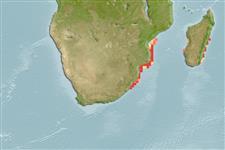Common names from other countries
sub class Elasmobranchii (ฉลามและกระเบน) (sharks and rays) >
Carcharhiniformes (Ground sharks) >
Pentanchidae (Deepwater catsharks)
Etymology: Halaelurus: halos (Gr.), sea; ailouros (Gr.), cat, probably an allusion to the vernacular “catshark,” so named for its cat-like eyes. (See ETYFish); lineatus: Latin for lined, referring to its 13 pairs of narrow dark-brown stripes. (See ETYFish).
Environment: milieu / climate zone / depth range / distribution range
นิเวศวิทยา
เกี่ยวกับทะเล,น้ำเค็ม สัตว์น้ำหน้าดิน; ระดับความลึก 0 - 290 m (Ref. 5510). Subtropical; 19°S - 31°S
Western Indian Ocean: Beira, Mozambique to East London, South Africa.
ขนาด / น้ำหนัก / Age
Maturity: Lm ? range ? - ? cm
Max length : 56.0 cm TL เพศผู้/กระเทย; (Ref. 244); 52.0 cm TL (female)
Short description
เครื่องมือที่ใช้ในการแยกชนิดสัตว์,สิ่งมีชีวิตออกจากกัน | สัณฐานวิทยา | ความยาวต่างๆ
เงี่ยงครีบหลัง (รวม) : 0; เงี่ยงครีบก้น: 0. A catshark with an upturned knob on the snout, a narrow head, and numerous small dark spots on the body (Ref. 5578). Pale brown with numerous pairs of narrow, vertical, dark brown stripes outlining obscure dusky saddles (Ref. 5578), cream below (Ref. 5510).
Found on the continental shelf and uppermost slope, on soft bottoms, from close inshore to 290 m (Ref. 5578). Feeds on small crustaceans, bony fish, and cephalopods (Ref. 5578). Although commonly caught by shore anglers, it is not generally considered a game fish (Ref. 12484).
Life cycle and mating behavior
Maturities | การสืบพันธุ์ | Spawnings | Egg(s) | Fecundities | ตัวอ่อน
Probably lays eggs, with up to 16 egg-cases per female; eggs retained until embryos reach advanced stage of development (Ref. 5578).
Compagno, L.J.V., 1984. FAO Species Catalogue. Vol. 4. Sharks of the world. An annotated and illustrated catalogue of shark species known to date. Part 2 - Carcharhiniformes. FAO Fish. Synop. 125(4/2):251-655. Rome: FAO. (Ref. 244)
IUCN Red List Status (Ref. 130435)
CITES (Ref. 128078)
Not Evaluated
Threat to humans
Harmless
Human uses
การประมง: ไม่มีผลประโยชน์; การตกปลาเป็นกีฬา: ใช่; สถานที่แสดงสัตว์และพืชน้ำ: สถานแสดงสัตว์น้ำของรัฐ
เครื่องมือ
Special reports
Download XML
แหล่งที่มาจากอินเตอร์เน็ต
Estimates based on models
Preferred temperature (Ref.
115969): 18.6 - 25.3, mean 22.7 (based on 22 cells).
Phylogenetic diversity index (Ref.
82804): PD
50 = 0.5078 [Uniqueness, from 0.5 = low to 2.0 = high].
Bayesian length-weight: a=0.00269 (0.00144 - 0.00502), b=3.05 (2.88 - 3.22), in cm Total Length, based on LWR estimates for this species & (Sub)family-body (Ref.
93245).
ระดับชั้นอาหาร (Ref.
69278): 4.5 ±0.60 se; based on food items.
ความสามารถในการกลับคืนสู่ปกติ (Ref.
120179): ต่ำ, เวลาต่ำสุดที่จะทำให้ประชากรเพิ่มขึ้นเป็น 2 เท่าใช้เวลา 4.5 - 14 ปี (Fec assumed to be <100).
Fishing Vulnerability (Ref.
59153): Moderate vulnerability (42 of 100).
